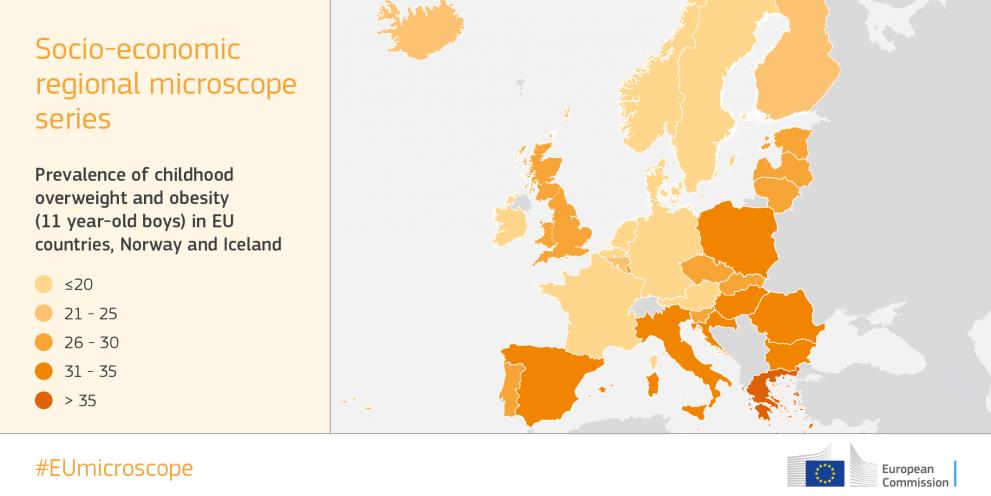
Childhood and adolescent obesity are alarming nearly everywhere in Europe.
However, a closer look reveals telling differences in regional, local and socio-economic patterns.
In a new report, JRC scientists illustrate the power of data and how exploring these differences can lead to targeted approaches and better results in fighting this modern epidemic.
The new JRC report, “Mapping and zooming in on childhood overweight and obesity” presents the scale of overweight and obesity among children in EU Member States through a series of maps.
The report then zooms in on one municipality in the North of Portugal to highlight a good example of using local data to define a solution adapted to the local reality.

The current rates of overweight and obesity among children and adolescents in Europe are alarming, reaching well over 30% in certain EU Member States
European Union, 2018
Urban planning, schools and level of education play a role
Overweight and obesity are associated with eating and drinking habits, physical inactivity, and sedentary behaviour.
There are also less obvious, yet equally important socio-economic and environmental factors behind the obesity epidemic.
These include urban planning, neighbourhood infrastructure, possibilities for active commuting such as on foot or by bike, exposure to marketing of foods high in fat, sugar, and salt, school food policies and education on nutrition, parents' occupation and many others, collectively shaping the opportunities for health that children and adolescents have access to.
EU response
These worrying figures have prompted the EU and its Member States to act and in 2014 an EU Action Plan on Childhood Obesity was launched, supported by JRC research in the field.
One of its focus areas has been schools, and how they can promote health and healthful behaviours, as summarized in the report Mapping of National School Food Policies across the EU28.
In order to support national, regional and local administrations in steering markets towards more health sensitive services through their purchases, the European Commission also issued a tool on Public Procurement of Food for Health.
Zooming in on a municipality that made a change
Analysing data at national level can be helpful to get an overall picture, however, when looking at data at regional and local level, high variations can be seen also within countries.
A closer look at this scale can help understand the underlying factors that may diminish children's health.
In the municipality of Gaia, in the North region of Portugal, the rate of childhood obesity ranges between 30 and 50% depending on the area.
The local authorities have been conducting comprehensive annual surveys in public schools, including the body measurements of every child.
The data obtained allows for a thorough knowledge of its population and in particular its children, matching the data with socio-economic status.
Equipped with the data and knowledge on the health and status of their children, the municipality decided to launch targeted measures to promote their health.
For example, all children attending public schools are now offered free breakfast and morning snacks, which adhere to carefully considered health-related criteria detailed in the Portuguese school food policy.
Reportedly, the introduction of these measures has virtually eliminated the consumption of calorie-dense and nutritionally poor snacks in schools.
The example from Gaia shows the power of data collected at local level, which should be used for evidence-informed and tailor-made policies.
Background
The report “Mapping and zooming in on childhood overweight and obesity” forms part of the JRC Socio-economic regional microscope series, a new line of short periodical publications, which aim to open-up new areas of analysis, and present the stories which can only be told using regional socio-economic data.
The report publication follows the Council Conclusions on "Healthy nutrition for children: The healthy future of Europe" of June 22, 2018.
Related Content
JRC report: Mapping and zooming in on childhood overweight and obesity
Socio-economic regional microscope series
Council Conclusions on "Healthy nutrition for children: The healthy future of Europe" (June 22, 2018)
European Commission thematic page on Nutrition and physical activity
Details
- Publication date
- 6 July 2018
